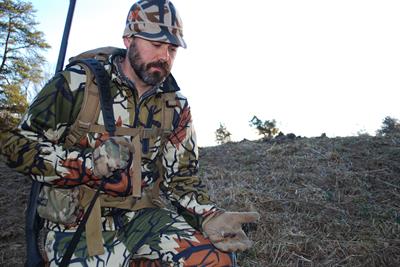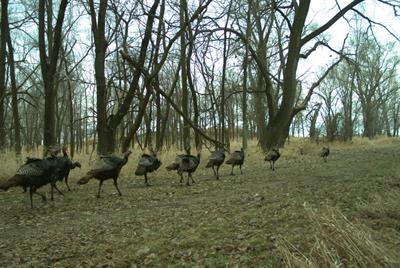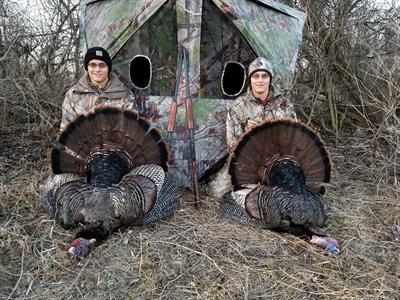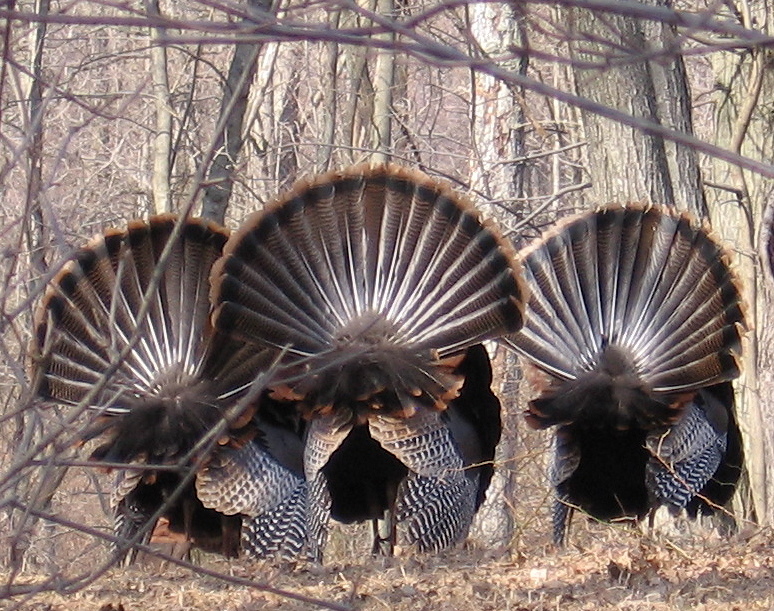I have a confession to make. For more than three decades, I’ve had an obsession. Although the objects of my obsession don’t know me personally (at least not until we meet in the woods), I share the thrill of hunting wild turkeys — particularly in the fall — with as many people as I can.
It all started one cold Saturday in November 1986. Afield on a West Virginia mountain with Jim Clay, founder of Perfection Turkey Calls, I watched in astonishment as Clay called in three jakes (young male turkeys).
Earlier Clay had pointed out fresh turkey droppings, recently made scratchings, and abundant turkey foods (berries, grasses, bugs, and various seeds and nuts) that showed we were on the right track. It was all utterly fascinating for someone like me who was new to hunting in general and had never pursued turkeys in the spring or fall.
When we finally caught up to the flock of jakes (which Clay earlier identified as male based on their droppings), Clay charged into them, yelling. I followed suit, although not sure why he was making such a ruckus. After we sat panting with our backs against a broad hardwood tree, he explained that by “busting” the trio, we had a much better chance to call them in to us. Turkeys, especially young ones, possess an innate fear of being separated from their flock-mates.
Clay then commenced what he called the “kee-kee run” — the call of lost young turkeys. From a distance, we heard frenzied, frantic kee-kees from our quarry. Not long after, I spotted all three birds charging toward us from different directions.
“Slowly get your shotgun up,” whispered Clay. “Turkeys have excellent eyesight and they can spot any kind of rapid movement.”
By the time the threesome had moved within shooting distance, I was a nerve-wracked mess. I had never experienced anything so exciting, so awe-inspiring, so wild and raw in all my life. I fired three times at the jakes, badly missing all three times.
But from that experience, I became devoted to all things turkey, pursuing them zealously in the spring and even more so in the fall. I thirsted to know more about the foods they ate, the types of trees and places where they roosted, and the habitats they — and all kinds of game and non-game wildlife — needed to thrive. In short, it was the day I began a lifelong quest to become a good woodsman and conservationist.
On one of our periodic hunts over the ensuing decades, Clay said to me, “You’re a true woodsman and fall turkey hunter for sure.” It was the highest praise I could have ever received from him.
Where Have All the Turkeys Gone?
Ten million wild turkeys roamed the United States just a few centuries ago. However, years of unregulated market hunting and habitat loss decimated turkey populations, and the birds disappeared from 18 of the 39 states where they were originally found. By 1920, the U.S. turkey population had dropped to somewhere between 30,000 and 200,000 (depending on who you ask).
Early efforts to rebuild wild turkey populations by catching and relocating them failed due to the difficulty of capturing wild birds. For several decades, state agencies instead tried breeding turkeys in captivity and releasing them into the wild, but these birds were unable to survive on their own. So biologists returned to the idea of capturing wild birds. A breakthrough came in the 1950s with the use of a cannon-fired net. State personnel detonated huge nets above flocks of turkeys that had been lured to an area using corn or other bait. Once captured, a flock was transferred to an area where few or no other wild birds existed. Success with this method — plus habitat restoration and more effective wildlife management — brought wild turkey populations back to around 7 million birds across 49 states today (Alaska is too cold). Other species — including whitetail deer, waterfowl, and quail — also benefit from ongoing restoration efforts and habitat work.
As turkey numbers rebounded, some state wildlife agencies introduced spring turkey seasons to take advantage of the abundant game.
In states that offer a fall turkey season, hunters can harvest wild turkeys of either sex. State wildlife agencies set fall bag limits based on turkey populations and carrying capacity over the winter. Unfortunately, few hunters pursue fall turkeys today. This means generations of hunters have lost out on the woodsmanship essential to success in the autumn forest — not only for turkeys but for all fall game.
I had to ask the now 72-year-old Clay about the lack of fall turkey hunters.
“People have to realize what turkey hunting was like before 1960,” Clay says. “Very few states held spring seasons, and there were very few turkeys in most states. So the guys who knew how to fall turkey hunt were men who had spent many years in the woods learning everything they could about a turkey’s foods, how to age signs the birds left to know whether a flock was nearby, and how to imitate the dozen or more sounds that turkeys make in the fall.”
For Clay’s first turkey hunts in 1958, family members would drive five hours from the West Virginia coal fields to the Monongahela National Forest in Pocahontas County, where flocks were rumored to exist. Wearing gray pants and brown overcoats (modern day camo had not yet been invented), the Clay clan walked through the forest hoping to “jump” turkeys.
If they did so, the group would pull out their one-piece box calls hollowed out from chunks of red cedar. And they would begin to scratch out some not particularly realistic clucks and yelps.
“My kinfolk and I weren’t successful for a long time,” recalls Clay. “It took years of observing turkey signs to decipher what it all meant. And it took years of listening to the turkeys to learn how to make the sounds they did. Along the way, I fell in love with fall turkey hunting and the need to become a good woodsman.”
Seasonal Shifts
Many of the old-time fall turkey hunters were disgusted when spring gobbler hunting became a thing, says Clay. “They said it was cheating to go after a spring gobbler because the toms were too lovesick and too easy to call in, especially when compared to calling in and killing a fall mature gobbler.”
I can attest to that fact. Although I almost always kill my two-bird limit during Virginia’s fall turkey season, I’ve only tagged three mature toms in the decades since 1986.
It takes a lot of skill and knowledge to call in any fall turkey, explains Clay. “Not only do you have to study signs and determine food sources to find birds in the fall, you also have to learn all the various calls and how jakes and jennies [young females] and mature hens and gobblers each have different pitches, cadences, and raspiness. The sounds you may have to make to call in a fall gobbler — his gobbles, yelps, clucks, purrs, kee-kees, and more — all sound different from those that a jake would make. And to top everything off, a fall gobbler might take hours to come in or even respond to your call, whereas a spring tom will almost always let you know he’s around with a gobble or two.”
That’s because in the fall, a mature gobbler’s goals are simply survival and food. In the spring, his priorities are sex, survival, and food — in that order, says Larry Proffitt, a nationally recognized turkey hunter from Elizabethton, Tennessee. Like Clay, he spends much of his falls and springs chasing after turkeys in multiple states.
“In the spring, too many people believe that all they have to do is drive an ATV up to a food plot, set up in a blind, put out some decoys, and make a few yelps,” says Proffitt. “It’s less Facebook-worthy to walk miles through the fall forest, decipher signs, learn calling nuances, and hope that you might encounter a flock,” but it’s that fall hunt that most stirs his sporting soul.
The long hours afield required to learn the craft and pursue the quarry is one major reason for fall turkey hunting’s decline. Many states that offer fall turkey hunting, including Virginia and West Virginia, report low participation rates. North Carolina instituted a fall turkey season a few years ago but discontinued it due to lack of interest.
Yet fall turkey hunting offers incredible opportunities. “You can learn more about turkey behavior and calls in one season of fall hunting than you can in ten springs,” says Matt Morrett, a pro staffer for Zink and Avian-X call makers.
Another factor is the timing of large game, small game, and waterfowl seasons, which more often than not coincide with the fall turkey hunting season in states that offer it. “One of the best things a state could do to encourage fall turkey hunting is to take its season out of the October and November time frame or add a late season,” says Clay.
Another way to boost fall turkey hunting would be to dedicate game tags that would have to be used only for the fall season, Clay suggests. In Virginia, for example, hunters can save their two fall tags for use in the spring season. Making fall turkey tags a “use it or lose it” proposition would boost fall participation.
Rejuvenating the Fall Season
Fall turkey hunting is a tradition that many hunters overlook today. It’s also great for introducing youth and novice adults to hunting. Morrett says that Pennsylvania initiated a three-day turkey season during the Thanksgiving holidays when gun hunting for bears and whitetails is not permitted. “Many young kids in Pennsylvania have no clue about the traditions of fall turkey hunting and what a great pastime it is,” he says. “The November three-day season gives us a chance to reconnect with the past.” Virginia and Maryland initiated mid-January turkey seasons to encourage experienced hunters to mentor youth and other non-hunters.
As a whole, however, states have fallen behind in promoting fall turkey hunting says Matt Lindler, acting Vice President of Communications for the National Wild Turkey Federation and editor of Turkey Country magazine. Data from the 2013-2014 season showed approximately 2.6 million spring turkey hunters and 657,000 fall turkey hunters nationwide. And those statistics may still inflate the number of fall turkey hunters. “The survey included all individuals who checked in a fall bird. Many of those turkeys, no doubt, were killed by hunters while they were sitting in stands or blinds and trying to kill deer or some other game,” says Lindler.
He urges states “to make more of a public relations effort to let people know of the health benefits of eating wild game like turkey.” Another step state fish and wildlife agencies could take is to legalize fall turkey hunting with dogs, allowed in nearly 30 states today. “Turkey dog hunters in states like New York, Virginia, Wisconsin, and Minnesota are very passionate about their sport and passing it on,” Lindler says. “It would be exhilarating for a kid or a novice adult hunter to experience turkey dogging.”
“Fall turkey hunting has so much to offer,” Morrett says. “Learning how to move through the woods, read signs, identify food sources, find game — that’s what a woodsman is.” Some of the best woodsmen in the world — Ben Rogers Lee (credited with bringing turkey hunting to the outdoors mainstream), Dick Kirby (founder of Quaker Boy Game Calls), Billy McCoy (turkey hunter and guide), and turkey calling champions Paul Butski and Denny Gulvas — were fall turkey hunters, he says. “The type of people who knew how to make wingbone calls from the bones of turkeys and look at turkey scratching and droppings and tell just how old they were. Knowledge like that is worth passing on to another generation.”
